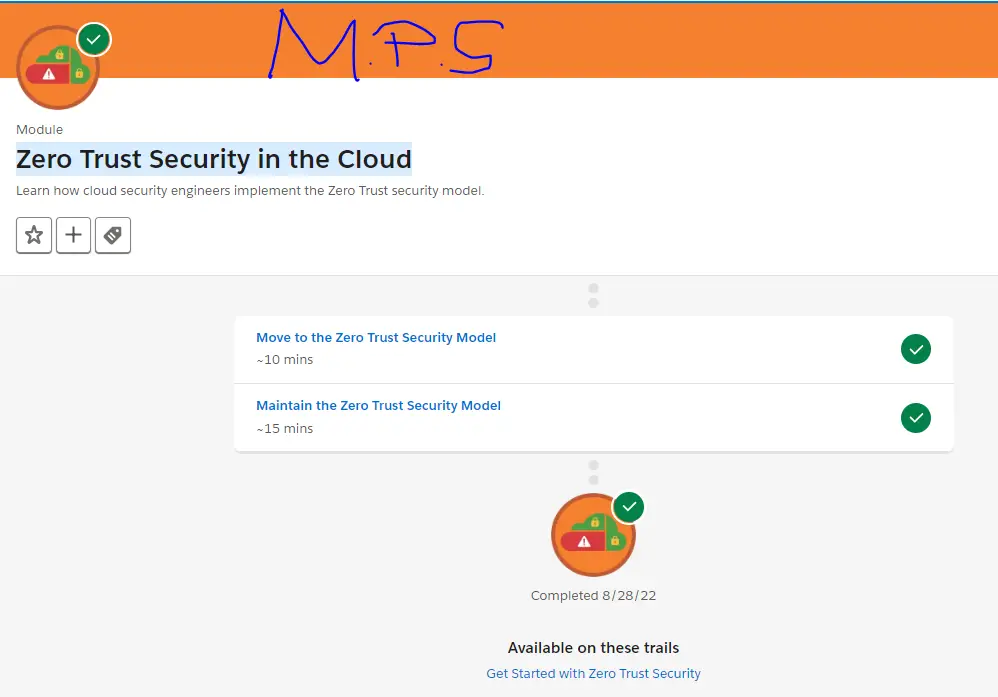In this tutorial, we will solve the question and Learn about the Zero Trust security and Zero Trust Security in the Cloud model.
After watching all these questions you are able to solve all questions in a single attempt and you will achieve 100 points by solving each module. Click here to solve the Zero Trust Security and Zero Trust Security in the Cloud module.
Module1: Zero Trust Security
#1.Get to Know the Zero Trust Security Model
Solve these quizzes and get +100 points.
Q1)Which of these options defines the Zero Trust security model?
#I)Nothing is presumed to be trusted.
#II)Zero Trust relies on perimeter-based security.
#III)Trust is established as a function of location.
#IV)Users access resources only from an organization-owned computer.
[bg_collapse view=”button-green” color=”#4a4949″ expand_text=”Show Answers” collapse_text=”Hide Answers” ] I)Nothing is presumed to be trusted. [/bg_collapse]
Q2)Which of these is a principle of the Zero Trust security model?
#I)Authorize once.
#II)Never trust, always verify.
#III)Maximize impact.
#IV)Collect and respond manually.
[bg_collapse view=”button-green” color=”#4a4949″ expand_text=”Show Answers” collapse_text=”Hide Answers” ] II)Never trust, always verify. [/bg_collapse]
Check the Quiz to Earn 100 Points
The second attempt earns 50 points. Three or more attempts earn 25 points.
#2.Identify Technologies Behind Zero Trust
Solve these quizzes and get +100 points.
Q1)Which of these statements is true about the technologies behind the Zero Trust security model?
#I)The technologies are brand new.
#II)The technologies can be sourced only from one specific vendor.
#III)The technologies are likely already being used in some capacity at your organization.
#IV)The technologies require you to buy all new security tools.
[bg_collapse view=”button-green” color=”#4a4949″ expand_text=”Show Answers” collapse_text=”Hide Answers” ] III)The technologies are likely already being used in some capacity at your organization. [/bg_collapse]
Q2)Which of these options defines the attack surface?
#I)A concept that focuses on authenticating and authorizing access continuously
#II)A tool that verifies identities and controls privileges
#III)A tool that adds a layer of protection for traffic from server-to-server and application-to-server
#IV)The number of all possible points where an unauthorized user can access a system
[bg_collapse view=”button-green” color=”#4a4949″ expand_text=”Show Answers” collapse_text=”Hide Answers” ] IV)The number of all possible points where an unauthorized user can access a system [/bg_collapse]
Check the Quiz to Earn 100 Points
The second attempt earns 50 points. Three or more attempts earn 25 points.
Module2: Zero Trust Security in the Cloud
Here you will solve the second module called Zero Trust Security in the Cloud. Learn how cloud security engineers implement the Zero Trust security model.

#1.Move to the Zero Trust Security Model
Solve these quizzes and get +100 points.
Q1)Which of these statements is true about moving to the Zero Trust security model?
#I)Zero Trust is a security model that can be used in both cloud and non-cloud implementations.
#II)Zero Trust can be implemented only in a fully remote work environment.
#III)Zero Trust relies on a defensible perimeter.
#IV)Zero Trust increases the risks of cloud computing.
[bg_collapse view=”button-green” color=”#4a4949″ expand_text=”Show Answers” collapse_text=”Hide Answers” ] I)Zero Trust is a security model that can be used in both cloud and non-cloud implementations. [/bg_collapse]
Q2)Which of these options is the first step to implementing the Zero Trust security model in the cloud?
#I)Map key processes and transaction flows.
#II)Identify applications, assets, data, services, and users.
#III)Architect your cloud infrastructure.
#IV)Purchase multiple third-party perimeter security systems.
[bg_collapse view=”button-green” color=”#4a4949″ expand_text=”Show Answers” collapse_text=”Hide Answers” ] II)Identify applications, assets, data, services, and users. [/bg_collapse]
Check the Quiz to Earn 100 Points
The second attempt earns 50 points. Three or more attempts earn 25 points.
#2.Maintain the Zero Trust Security Model
Solve these quizzes and get +100 points.
Q1)Which of these statements about implementing Zero Trust is true?
#I)Implementing Zero Trust is a one-and-done process.
#II)Implementing Zero Trust usually improves the user experience with less authentication requests.
#III)Implementing Zero Trust across your enterprise architecture and cloud providers requires careful planning.
#IV)Implementing Zero Trust doesn’t require any specialized staff skill sets.
[bg_collapse view=”button-green” color=”#4a4949″ expand_text=”Show Answers” collapse_text=”Hide Answers” ] III)Implementing Zero Trust across your enterprise architecture and cloud providers requires careful planning. [/bg_collapse]
Q2)Which of the following metrics can help you measure gains from implementing Zero Trust?
#I)Number of firewall rules in place
#II)Increase in time to contain an attack
#III)Increase in time to detect an attack
#IV)Number of detectable events and indicators of compromise (IOCs)
[bg_collapse view=”button-green” color=”#4a4949″ expand_text=”Show Answers” collapse_text=”Hide Answers” ] IV)Number of detectable events and indicators of compromise (IOCs) [/bg_collapse]
Check the Quiz to Earn 100 Points
The second attempt earns 50 points. Three or more attempts earn 25 points.
List of Modules:
- Identity Management In Slack
- Protect Your Salesforce Data
- Develop A Heroku App That Integrates With Salesforce
- Prospecting For Better Sales
- One-On-One Meetings
- Innovation Customer Discovery
- What Is Innovation Basics
- Impacts Of The Fourth Industrial Revolution
- Healthy Eating With Salesforce’s Executive Chef
- Engagement And Retention
